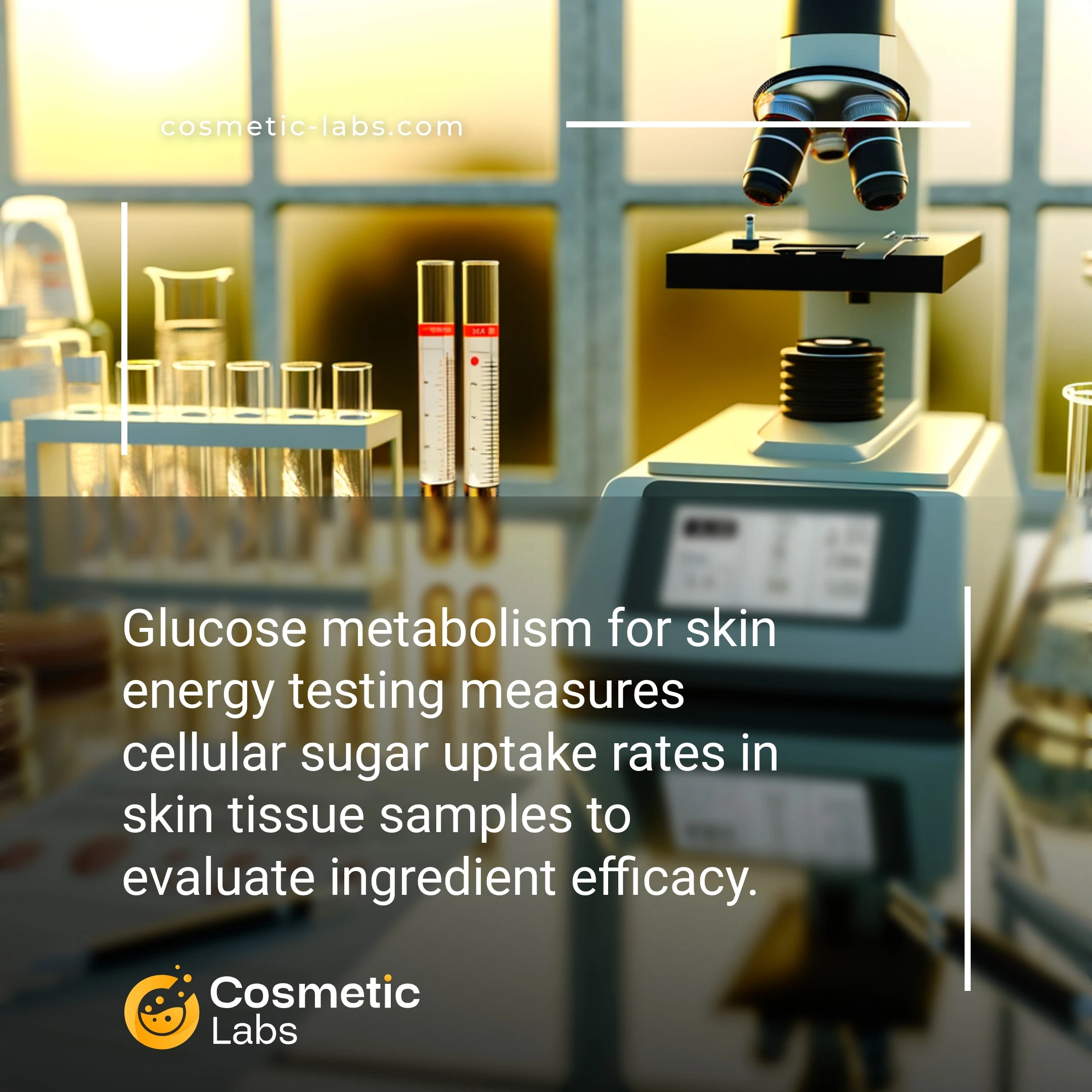Glucose Metabolism Testing for Skin Energy Lab Services

What is Glucose metabolism?
Glucose metabolism testing for skin energy measures how effectively cosmetic ingredients boost cellular energy production in skin cells through glucose uptake and ATP synthesis pathways. Labs use fluorescent glucose analogs and mitochondrial activity assays to quantify ingredient performance, typically showing 15-40% increases in cellular energy output. This testing validates anti-aging claims by proving ingredients actually enhance skin cell metabolism rather than just providing surface hydration.
Why do you need this service?
Cosmetic labs use glucose metabolism testing to validate anti-aging claims for serums and creams targeting cellular energy production. Brands rely on these assays to demonstrate how active ingredients like peptides, vitamins, and botanical extracts boost skin cell ATP synthesis and mitochondrial function. Testing typically measures glucose uptake rates and metabolic enzyme activity in keratinocytes, providing quantifiable data for marketing claims about improved skin vitality and reduced fatigue signs.
Who provides Glucose metabolism services?
All cosmetic labs providing Glucose metabolism services
There is no company providing these services at the moment.
Glucose Metabolism Testing for Skin Energy Assessment
Glucose metabolism testing measures how effectively your cosmetic formulations enhance cellular energy production in skin cells. Labs on our platform use advanced biochemical assays to evaluate how active ingredients influence glucose uptake, ATP synthesis, and metabolic pathways that power skin renewal and repair processes.
Cellular Energy Production Analysis
Testing facilities measure glucose consumption rates and ATP generation in cultured skin cells treated with your formulations. This data shows whether your ingredients actually boost cellular energy or just claim to do so.
Key measurements include:
- Glucose uptake rates in keratinocytes and fibroblasts
- Mitochondrial respiration activity
- Lactate production levels
- Oxygen consumption rates
Results help you validate anti-aging claims and optimize ingredient concentrations for maximum metabolic benefit.
Metabolic Pathway Evaluation
Labs analyze specific metabolic enzymes and pathways your ingredients target. They test hexokinase activity, glycolysis rates, and citric acid cycle efficiency to pinpoint exactly how your formulation affects skin cell metabolism.
Testing protocols examine:
- Enzyme activity profiles before and after treatment
- Metabolite concentration changes
- Gene expression of metabolic markers
- Time-course metabolic response patterns
This data supports product positioning and helps you communicate the science behind your skin energy claims to consumers and retailers.
Connect with specialized testing labs through our platform to validate your formulation’s impact on skin cellular energy and metabolism.
Applications of Glucose Metabolism Testing for Skin Energy Assessment
Cosmetic labs use glucose metabolism testing for skin energy assessment to validate product claims about cellular vitality, anti-aging benefits, and metabolic skin health enhancement.
Anti-Aging Product Development and Validation
Labs measure glucose uptake rates in skin cells to evaluate how anti-aging ingredients affect cellular energy production. This testing reveals whether peptides, vitamins, or botanical extracts actually boost mitochondrial function and ATP synthesis in dermal fibroblasts.
Testing protocols track glucose consumption patterns over 24-72 hour periods using fluorescent glucose analogs and spectrophotometry. Results show percentage increases in metabolic activity, typically ranging from 15-40% for effective anti-aging compounds. These measurements support claims about improved skin vitality and cellular renewal.
Energy-Boosting Skincare Formulation Testing
Product developers rely on glucose metabolism assays to screen caffeine, niacinamide, and CoQ10 formulations for their ability to enhance skin cell energy production. Labs use oxygen consumption measurements alongside glucose uptake to create complete metabolic profiles.
Testing involves exposing cultured keratinocytes to product samples and measuring metabolic flux changes using Seahorse XF analyzers or similar bioenergetics platforms. Data shows real-time energy production rates, helping formulators optimize ingredient concentrations for maximum cellular activation without cytotoxicity.
| Test Parameter | Measurement Method | Typical Results Range | Application |
|---|---|---|---|
| Glucose Uptake Rate | 2-NBDG fluorescent assay | 10-50% increase vs control | Anti-aging efficacy |
| ATP Production | Luminescence detection | 20-60% enhancement | Energy-boosting claims |
| Oxygen Consumption | Seahorse XF analysis | 15-45% improvement | Metabolic activation |
| Lactate Production | Enzymatic colorimetric | 5-25% reduction | Metabolic efficiency |
Partner with specialized cosmetic labs on our platform to access glucose metabolism testing services that validate your product’s energy-enhancing claims with precise, regulatory-compliant data.
